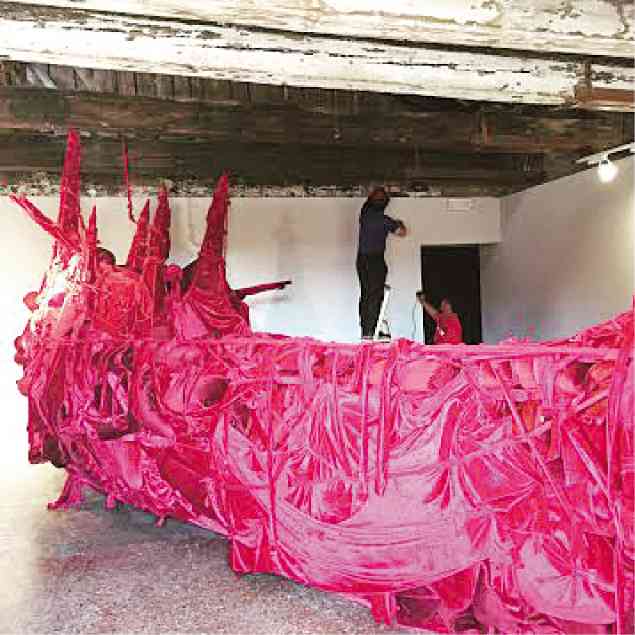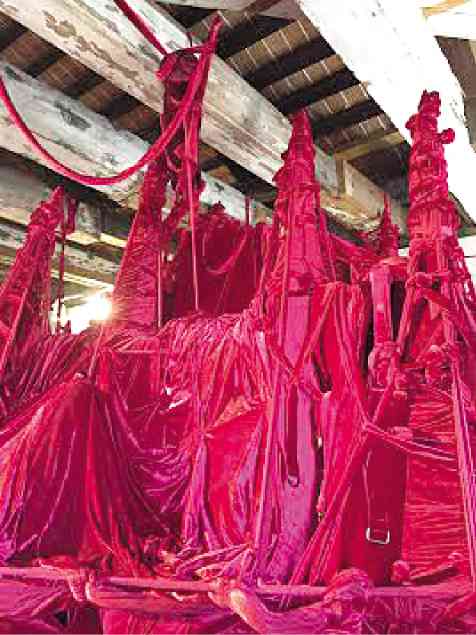
contrast to the height of the workers. José Tence Ruiz had to transport his work bar by bar from Manila to Italy. PHOTOS BY CATHY CAÑARES YAMSUAN
Moored inside one of the upper rooms of the impressive Palazzo Mora in Venice, Italy, is an evocation of the BRP Sierra Madre, the World War II-vintage military ship handed over by the US to the Philippines in 1976.
The sculpture called “Shoal” is a steel structure, rebuilt bar by bar from intermedia artist José Tence Ruiz’s atelier in Manila. It measures about 20 feet, is padded throughout with pillows and belts, and is entirely covered in gold-flecked burgundy velvet.
This, however, fails to give it a look of luxury and elegance. Rather, the chaotic mix of glaring color and hard and soft material evokes “flotsam,” “debris” and “improvisation.”
Three reasons
Ruiz’s fondly called “slum fortress” is one of the three reasons why Palazzo Mora, the venue of the Philippine pavilion of the 56th International Art Exhibition, aka Venice Art Biennale, has been enjoying heavy foot traffic since the festival opened on May 9.

Philippine Sea. Ruiz wrapped the “ship” in burgundy velvet similar to that worn by the Señor Nazareno in Quiapo to allude to the religiosity of Filipinos. But “Shoal” also connotes the chaos of the country’s politics. PHOTOS BY CATHY CAÑARES YAMSUAN
Featured along with Ruiz’s work is a 20-minute, three-channel video by filmmaker Mariano Montelibano III called “A Dashed State,” a commentary about hidden threats to rural life in a coastal barangay in southern Palawan.
There is also the digitally remastered 1950 Filipino film “Genghis Khan” that pavilion curator professor Patrick Flores used as a peg to stitch together his concept, “Tie a String Around the World,” as the Philippines’ biennale theme.
What does a rusty old ship beached on Ayungin Shoal reinterpreted as a velvet-clad vessel have to say about the Philippines?
Many things, actually, Ruiz said in an exclusive interview with Inquirer Lifestyle in Venice.
“The velvet, we associate with sanctity. Before Easter Sunday, we drape the santo inside our churches with velvet, either red or deep purple. Burgundy is also the color of the Nazareno (Black Nazarene statue) in Quiapo Church. I like the association,” he explained.
The artist said he is also fascinated by the ship’s “strange history.”
From the official catalogue distributed to pavilion visitors: “The Sierra Madre at one time was the USS Harnett County, built as a tank-landing ship for World War II and then repurposed as a floating helicopter and speedboat hub in the rivers of Vietnam.
“In 1970 the US gave the ship to the South Vietnamese and in 1976 it was passed on to the Philippines… Today it is beached on a shoal called Ayungin in the West Philippine Sea,” said the catalogue.
Claim indicator
Sierra Madre is parked with a purpose—as an indicator of the country’s claim to specific islands in the area that China has declared it also owns.
Ruiz pointed out that Filipino soldiers stationed in Ayungin live in the harshest conditions. “No water, no electricity and, until recently, hinaharang pa ang deliveries,” he said.
Ruiz insisted the marooned vessel serves as a unique icon. “Tayo lang ang may ganyan. It’s our beacon. It speaks about us. Hindi tayo maaksaya, poor tayo na tao,” he said.
But the associations do not stop at economy, national security, or hues.
“I don’t want to be stuck to the journalistic story. There is that bigger story about the culture of our country. Like the Quiapo-Nazareno (phenomenon) na siksikan ang tao, na nag-aagawan. I want to suggest all those things,” Ruiz added.
Quiapo is not only about seasonal penitents. It is also about the hellish traffic in Manila. The possibilities are endless, and Ruiz starts trailing off in stream-of-consciousness fashion.
He talked about how the room that houses “Shoal” smells similar to the Quiapo Church and other local churches. The sprinkling of agua de Peru was deliberate.
“You can smell that resin-like scent. It reminds you of being in the dark sacristy of Quiapo Church,” he explained.
“Other Southeast Asian countries are associated with the color saffron. Tayo, red. If you have only three minutes to look at hundreds of works (in the biennale), red works for a person to remember… (Also), hindi subdued ang mga Pinoy. We are a bit shy pero ’di tayo Zen,” the artist added.
Dream and nightmare
Ruiz stressed that underneath the velvet is steel covered with pillows of different sizes “because I want it to feel like a dream and a nightmare, because that’s what you own when you have an identity.
“It’s hard to be yourself but it’s great to be yourself. As Filipinos, we own the dream and the nightmare. All identities have that neurosis. The Singaporeans also hate and love themselves. The Brits, I’m sure, have something to say and the Russians have something to say,” he pointed out.
The pillows, meanwhile, also suggest “tumors.”
Ruiz said this is because Philippine history is “full of illnesses (mga sakit-sakit), things we don’t like about ourselves, our failed revolutions, hints of corruption. It’s a statement about the entirety of the world and of us in the world.”
A female guest wondered aloud why belts sprout all over the ship.
“What do you think?” Ruiz playfully challenged the woman. “Are you a religious person? What do you think of people who hold on to religion? Like they’re wearing straitjackets, no?
“Religion can be both a straitjacket and a release. Also, belts are a way of putting people together,” he noted.
“Shoal” may be inanimately stranded in a palazzo, but Ruiz hopes that the abstract image it presents would trigger a range of emotions.
“Maraming mahuhugot, and that’s what I think art should do in Venice—allow the people to enter our culture in an open image,” he said.

